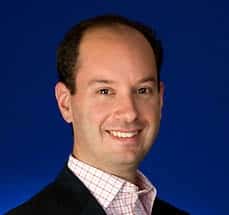
A couple of months after being jettisoned in an executive restructure, former AOL (NYSE: AOL) global advertising president Jeff Levick has surfaced as the guy to lead Spotify’s advertising ambitions.
Levick has just become Spotify’s chief advertising officer, according to his LinkedIn (NYSE: LNKD) profile, and a source has confirmed. Initially, it looked like Levick had become chief revenue officer, but turns out his role relates to advertising, based in New York.
Although Spotify sees its free, advertising-supported service as driving premium subscriptions, it is also a model that generates millions in its own right. Advertising comprised 40 percent of its income at its last disclosed year.
To non-subscribers, Spotify currently runs audio ads between songs, banners in its desktop app window and experiments with other visual formats.
Levick’s addition is a sign that, having built a healthy European business and having finally introduced itself to the world’s largest market, Spotify is now ready to go full tilt at a monetisation phase, as a proper, post-startup business.
The company now has at least 35 U.S. staff. Levick will head building out a larger sales team in both the U.S. and globally. Currently, most of Spotify’s commercial operations are in London, while its developers are in Stockholm and main execs… well, they have been living on planes over the mid-Atlantic for the last year.
Spotify has attracted 1.6 million paying customers out of 10 million users and recently tightened its free music plays in order to continue operating with the green light from record labels, which own equity in the company and which, having seen Spotify build a significant audience, now want it to generate real subscription income.
Mog and Rdio on Wednesday both introduced free service options to mimic the kind of freemium leverage on which Spotify has grown its subscriber count.
When Levick, a former Google (NSDQ: GOOG) VP, was let go in two months ago, AOL appeared to be on an upswing. The company’s Q2 display ad revenues were up 14 percent globally and 16 percent in the U.S.. But the third party ad network numbers, which were run by Levick’s replacement, Ned Brody, were even better with a 29 percent gain.
Given the strength of the network, AOL decided to consolidate its advertising unit, amid a wider reorg that resulted in several executive layoffs.
Levick’s primary focus was on building up the premium ad sales functionality with the introduction of the Project Devil, large-format ad units. The company placed a major bet on the adoption of those units by partners such as Hearst, WSJ.com, FoxNews.com and Meredith Corp. (NYSE: MDP) sites. While the ad format has gotten the endorsement of the Interactive Advertising Bureau and is generally considered to look good, it still has yet to see wide adoption.
Spotify is obviously in a different position. Having just arrived in the U.S. with an existing ad model, Levick’s job will largely be translating it to an American audience of marketers. Given the excitement that’s been built up with Spotify, the task is in many ways easier than the turn-around job he was charged with heading at AOL. As a company that is riding a wave of interest, Levick, who is primarily regarded as a data guy since his Google ad days — as well as a deal-maker — should feel a certain comfort in his new post.